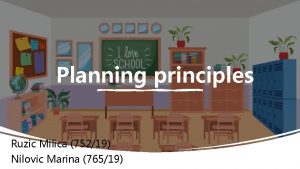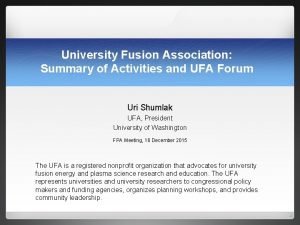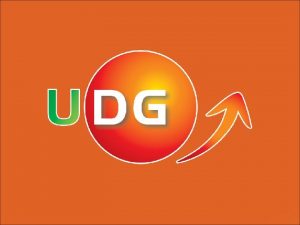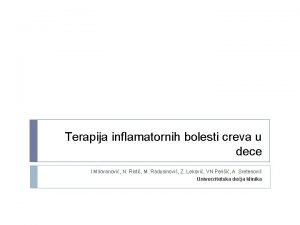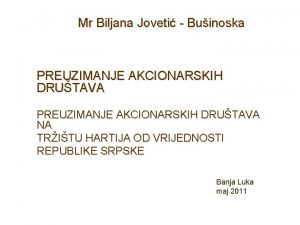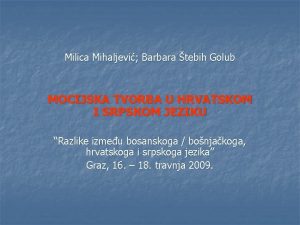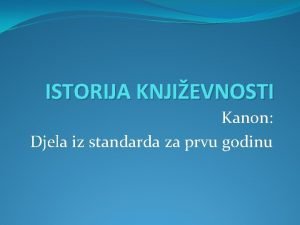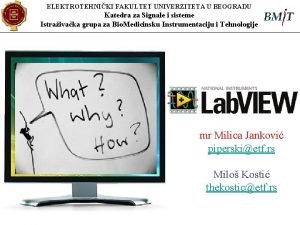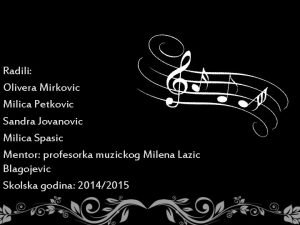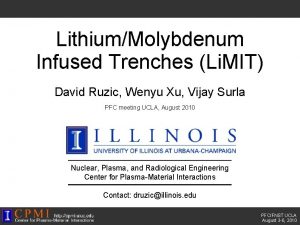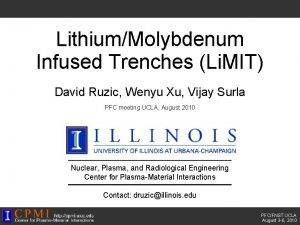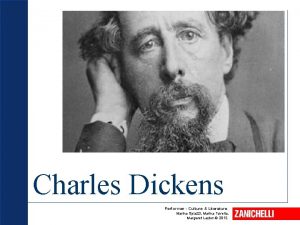Planning principles Ruzic Milica 75219 Nilovic Marina 76519












- Slides: 12

Planning principles Ruzic Milica (752/19) Nilovic Marina (765/19)

THE PRINCIPLES OF PLANNING As teachers, we devote a great deal of time and thought to the what and the how of teaching. What will we teach? How should the information be presented? How will we know that students know and can use the information? Good teaching doesn’t just happen; it is well planned and is aligned in several ways. First, the written curriculum, the teaching strategies, and the methods of evaluation are all aligned to each other; that is, we align what we say we are going to teach (i. e. , state standards, local standards, curriculum, and classroom objectives) with what we actually teach our students and what we assess them on.

This alignment can be shown visually as an equilateral triangle, with all sides being equal in importance and with the student in the middle. ◦ Within each of these factors (curriculum, teaching, and assessment) are microalignments that help assure that all students will know and understand the information. ◦ Throughout this presentation, we will examine this microprocess and the components that help to make it successful.

WHY GOOD PLANNING MAKES FOR GOOD LEARNING EXPERIENCES One of childrens’ favorite stories is Alice in Wonderland. A muchquoted passage from Alice’s adventures is the exchange between Alice and the all-knowing Cheshire cat. Alice is lost and asks the cat for directions. The Cheshire cat asks her which way she is going. Turning, she replies that she is not sure. The cat says that if she does not know where she is going, it does not matter which way she goes. That dialogue provides a perfect model for why good planning makes for good learning experiences. For our students’ sake, we need to know specifically where we are going with

Three-step process in planning 1. Ask what it is that we want students to know and be able to do as a result of the learning 2. We must examine how we will know that our students are learning and that they can perform tasks as a result of the learning 3. We must identify which instructional practises will assure us that students learn and that they can use the information provided

ü AIM Principles for good lesson planning -be realistic -not the things teachers intend to do, but what the students are able to do by the end of the lesson ü VARIETY -different types of activities and a wide selection of materials ü FLEXIBILITY -extra and alternative tasks and activities to cope with unexpected situations ü LEARNABILITY -contents and tasks should be within the learning capability of the students ü LINKAGE -stages and steps are linked so that the lesson transits smoothly

• Notice that the student is in the middle of the model provided triangle; that is no accident. The written, taught, and assessed curriculum should be student centered; that means that we teach what is best for the student, rather than what is best for politicians, communities, or other adults. What do students need to know and be able to do in order to be successful is at the heart of what we teach. • Anytime decisions are made in the classroom or school, the underlying issue should always be, “Is this better for the students? ” If the financial decision, the curriculum decision, or the testing decision does not benefit the students, either directly or indirectly, then the decision should be

• As teachers we have an obligation to our students to teach them the essential skills, processes, and facts that will help them to be successful now and in the future. Everything that we teach should be researchbased and should be taught in such a way that it facilitates meaning and self-reliance. Providing meaning helps students to put the information into long-term memory, and it builds intrinsic motivation. When we provide skills and structures to students that they can use

Preplanning tasks Before planning a lesson, it is important that you know your students. A teacher can no more plan for a lesson without knowing the strengths and weaknesses of her students Look at your student data (i. e. , state and national tests, record of attendance, health screening, socioeconomic status, and local testing for special programs). Look for both strengths and weaknesses. If you are unsure about the prerequisite skills that your students bring to your classroom, you can assess them with a pre-test, skills test, discussion questions, or questionnaire to help you plan appropriately.

If the data shows that students in your classroom tend to do significantly better in reading than in mathematics, this would be a trend. The trend should be analyzed to find its cause: At what point did the gap occur? Are there gaps in the textbooks and other materials being used in your school? Do teachers in your school have the requisite skills and resources needed to teach mathematics? Once preplanning has been completed, you are ready to plan a lesson that will help students to learn authentically Authentic learning takes place when students truly know the information and can perform tasks based on that information consistently. Authentic learning is not memorizing material only long enough to be tested and then promptly forgetting it: it Authentic learning assures that students understand the material

“A teacher is a compass that activates the magnets of curiosity, knowledge, and wisdom in the pupils. ” – Ever Garrison “Teaching kids to count is fine, but teaching them what counts is best. ” - Bob Talbert Tell me and I forget, teach me and I remember, involve me and I learn.

Thank you for your attention!
